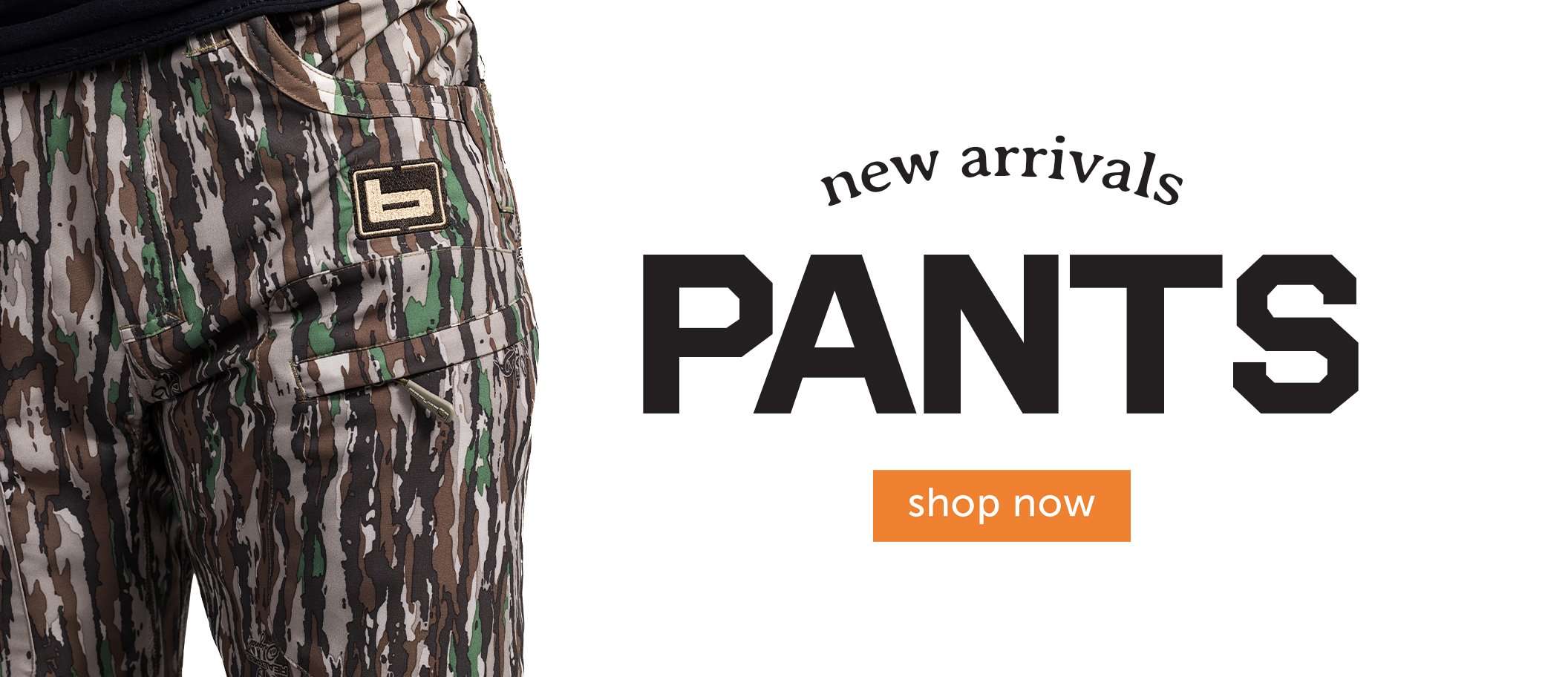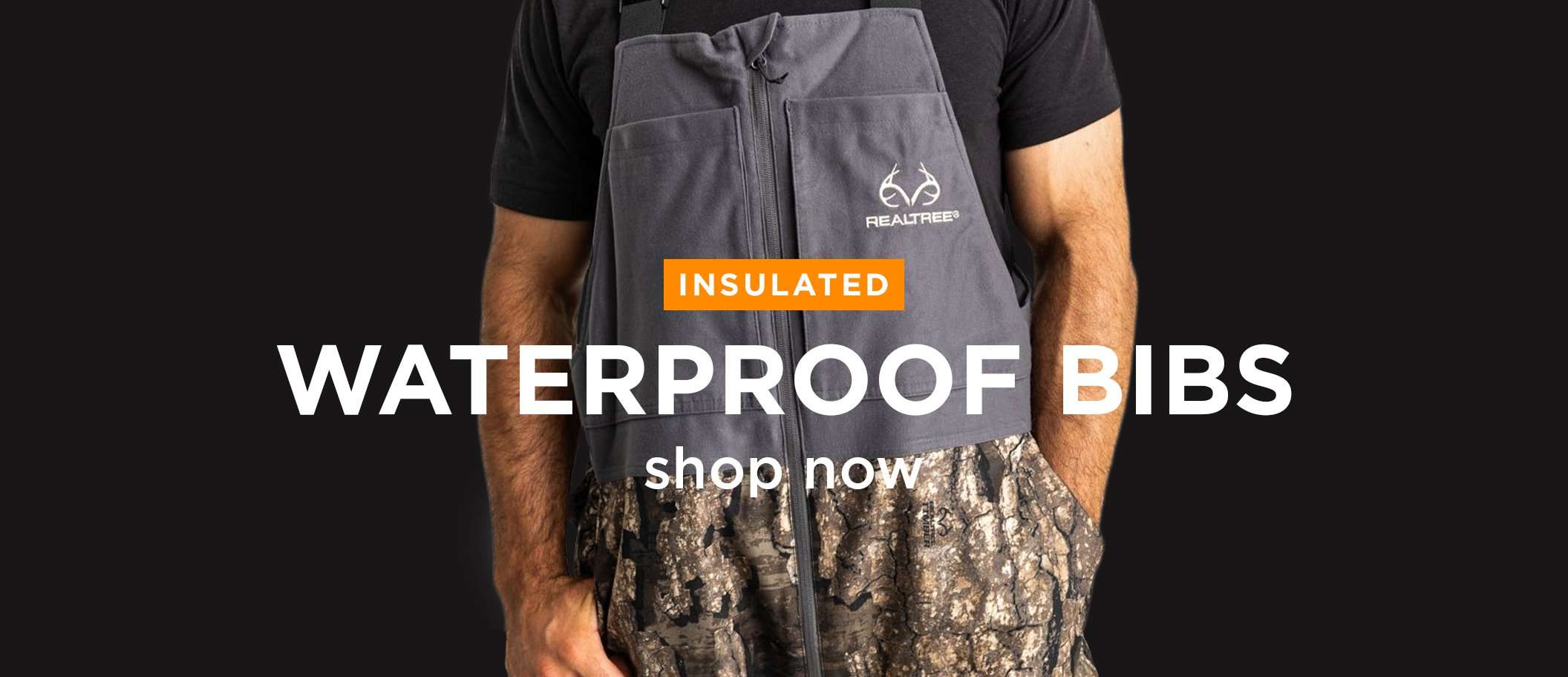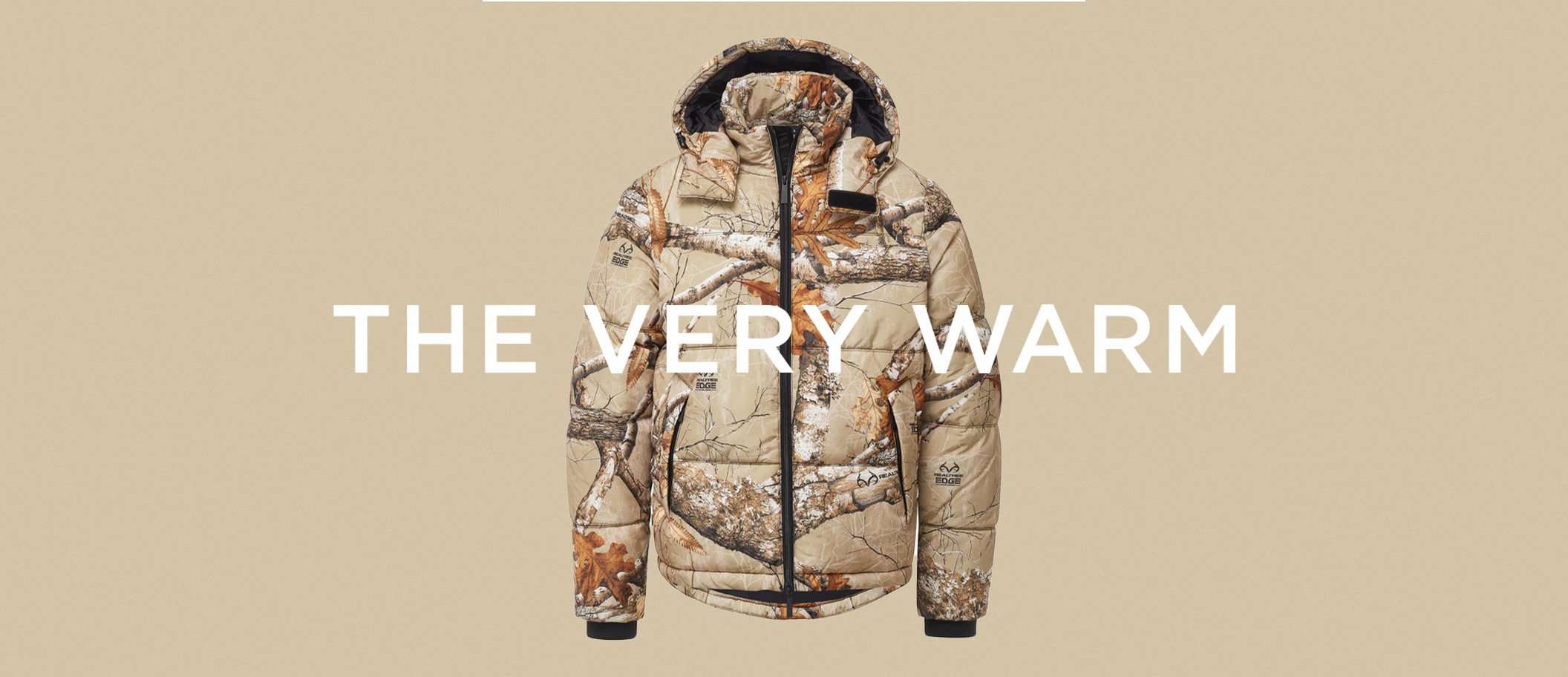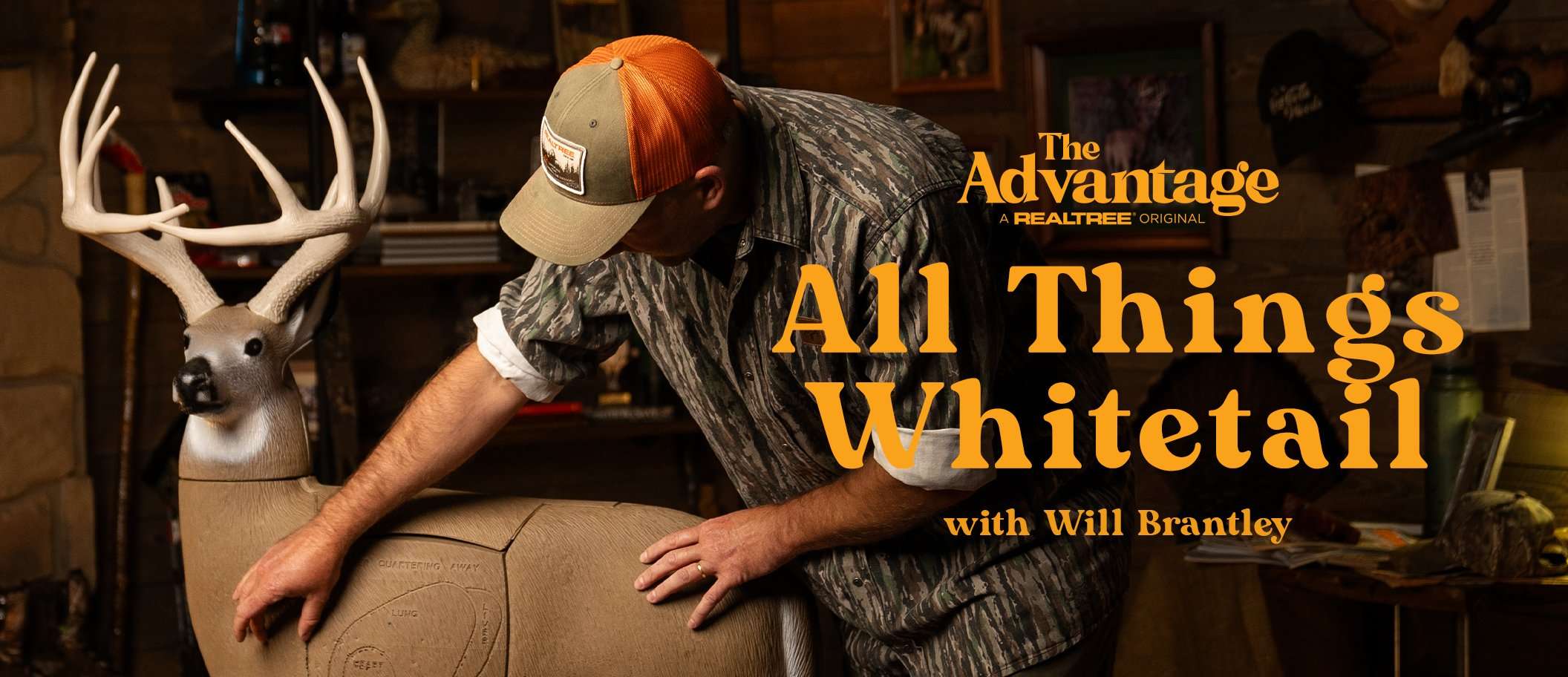These loads prove you don’t need a magnum shotgun to be an effective turkey hunter
If present-day me could travel back in time to talk about the future with teenage me, teenage me would be flabbergasted. Maybe not about artificial intelligence or electric cars, but certainly that my favorite turkey gun is now a .410. I would try to explain that it’s nearly as effective a 3½-inch lead turkey load, but teenage me would laugh, sling his 10-pound magnum 12 over his shoulder and lug it over the next ridge, certain that the old man from the future had lost his mind.
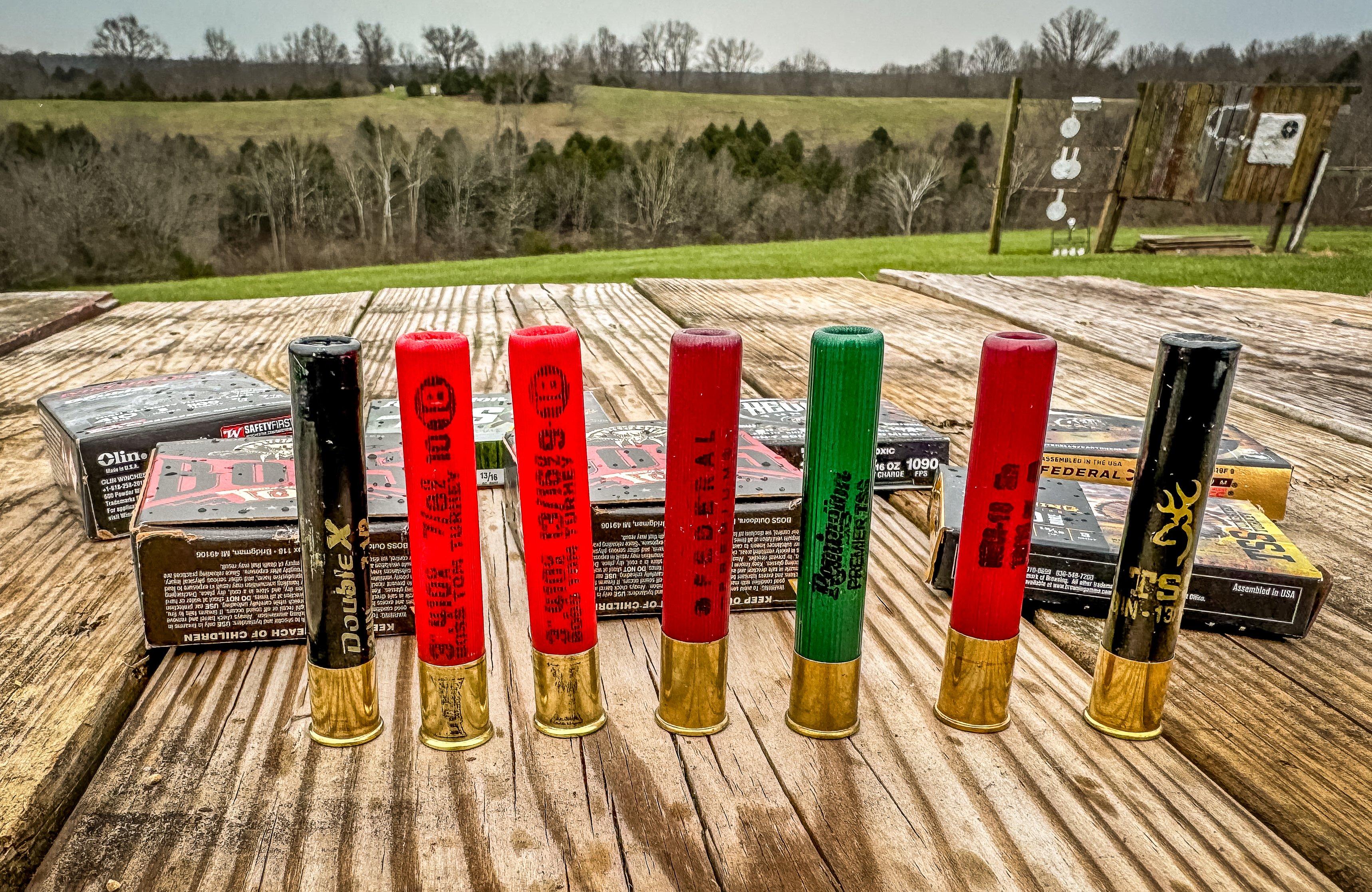
Modern shotshell technology has turned the .410 into a legitimate turkey gun. Image by Michael Pendley
But it's the truth. Modern shotshell technology, especially the introduction of heavier-than-lead tungsten super shot, means that manufacturers can now pack enough pellets into a 3-inch .410 hull to make it an effective turkey load. Because TSS is so much denser than lead, the standard rule of thumb is that you can go up in shot size about four spots over lead shot and still retain about the same amount of downrange energy. That means a No. 9 TSS pellet is equivalent to a No. 5 lead pellet, and a No. 10 TSS pellet has about the same energy as a No. 6 lead pellet.
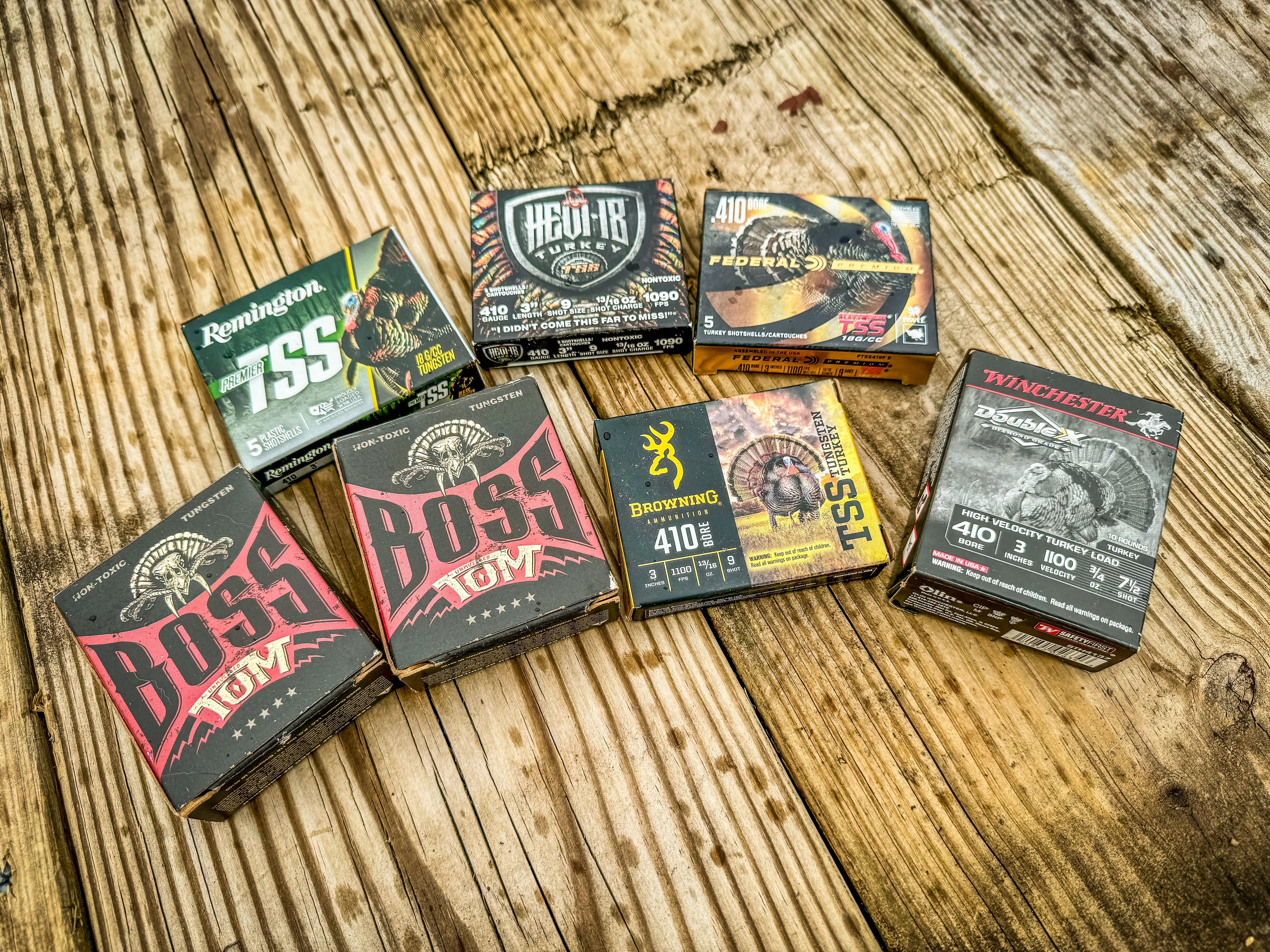
All but one of the tested shells were loaded with TSS shot. Image by Michael Pendley
Because a 3-inch .410 hull holds less than an ounce of shot, manufacturers traditionally couldn’t fit enough of the bigger lead shot into a shell to make an effective turkey load. Besides that, shot sizes larger than 7.5 tend to bind up against one another and wedge when passing through an extra-full turkey choke, known as bridging, causing a blown-out pattern.
Modern 3-inch TSS turkey loads hold about ¾ ounce of shot. For No. 9 TSS, that translates to a little fewer than 300 pellets. For No. 10, that increases to more than 400 shot pellets. For comparison, there are about 340 No. 5 lead pellets in a normal 2-ounce 12-gauge turkey load. As you can see, we’re dealing with pretty similar shot numbers and almost identical downrange energy.
Couple that with the fact that .410 guns are light and have a fraction of the recoil of a magnum 12, and you can see why more hunters, especially youngsters, are making the switch. In fact, demand is so high that some of the most popular loads (such as APEX) were already sold out at the time of this test.
***Don’t Miss: *THE BEST 12-GAUGE TURKEY LOADS OF 2024
THE TEST
As with my 20-gauge test, I patterned these loads at 30 yards. I believe that is a good average distance and that most turkeys taken each year are probably there or even closer. Will a .410 loaded with TSS shot cleanly take a turkey at longer distances? Absolutely. But each gun and choke combination will yield different results with each load. It’s up to you to head to the range and find out just how far the maximum range is for your gun. Although these shells hold a nearly equivalent amount of shot to a 12-gauge lead turkey load, there are far fewer pellets than in a 20 or 12 loaded with the same TSS pellets. There are less than half the pellets of most 20-gauge loads and well less than a quarter of the shot numbers of the heaviest TSS magnum 12-gauge loads. That means there is less margin for error, and the longer the shot, the tighter that margin gets. Could I kill more birds with a bigger gun? Likely, but instead of squeezing the trigger on a hung-up bird at 50 yards like I would with a 12 or even a 20-gauge, with my .410, I just say the bird won that round, and I’ll get him next time.
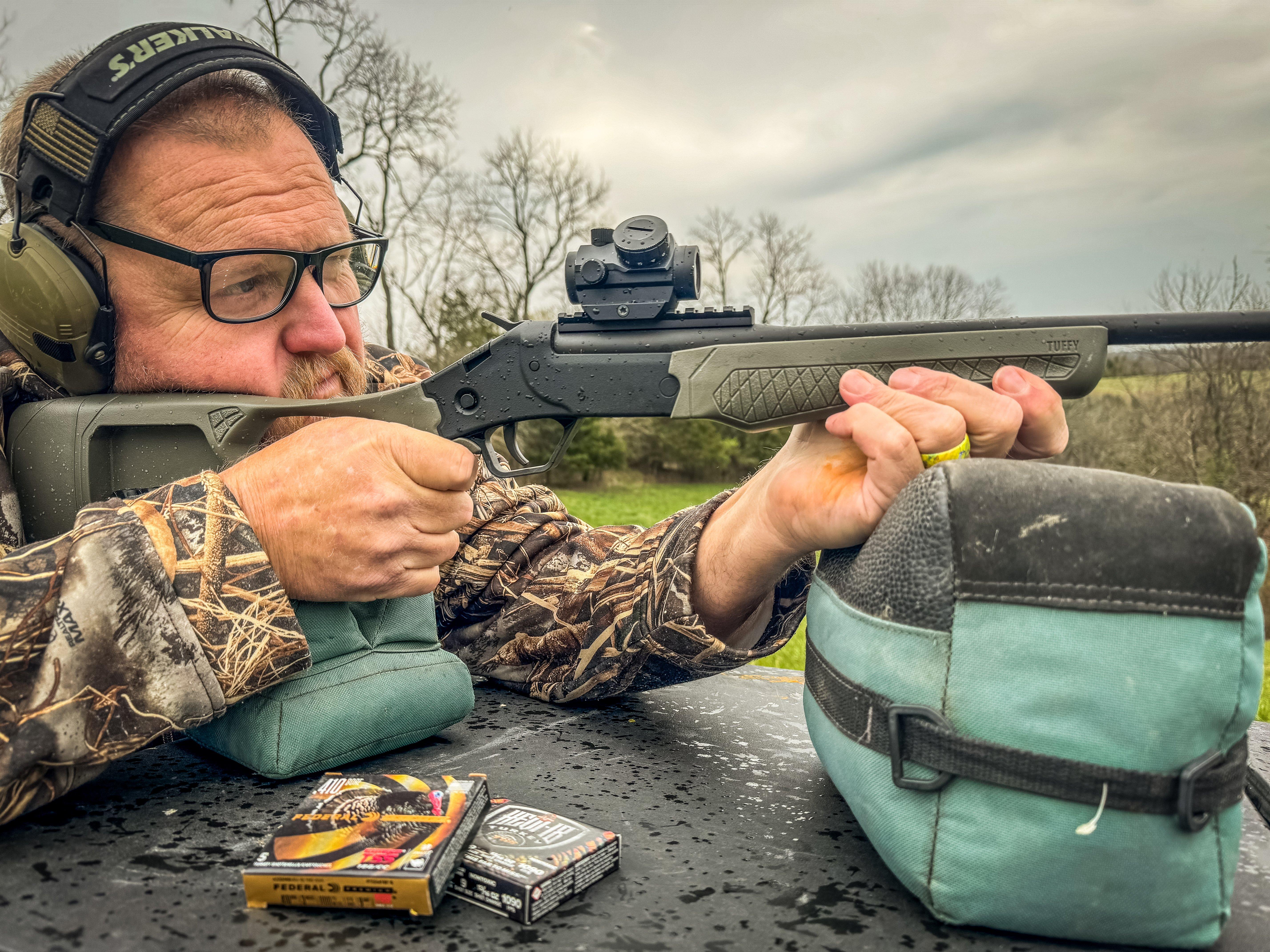
Test shots were taken from a bench at a 30-yard target. Image by Michael Pendley
I shot each load three times from the bench and took the average of the pellet counts inside a 9-inch circle. Point of impact varied between loads, but not as much as with the 20-gauge loads I have tested previously.
My test gun was a Rossi SS Poly Tuffy Turkey outfitted with the factory extra-full choke and a red-dot sight. The gun weighs less than 4 pounds loaded, so it’s a feather compared to my magnum 12-gauge guns. I’ve killed turkeys with this gun the past two seasons, and it is my go-to for taking young hunters afield because of the light weight and tame recoil.
Although pellet counts inside the 9-inch circle rivaled or even surpassed some of the 20-gauge loads I tested, the number of hits outside that circle dropped off in a hurry. That means a smaller margin for error when aiming. If you are going to hunt with a .410, a quality red-dot will increase your shot-to-kill ratio.
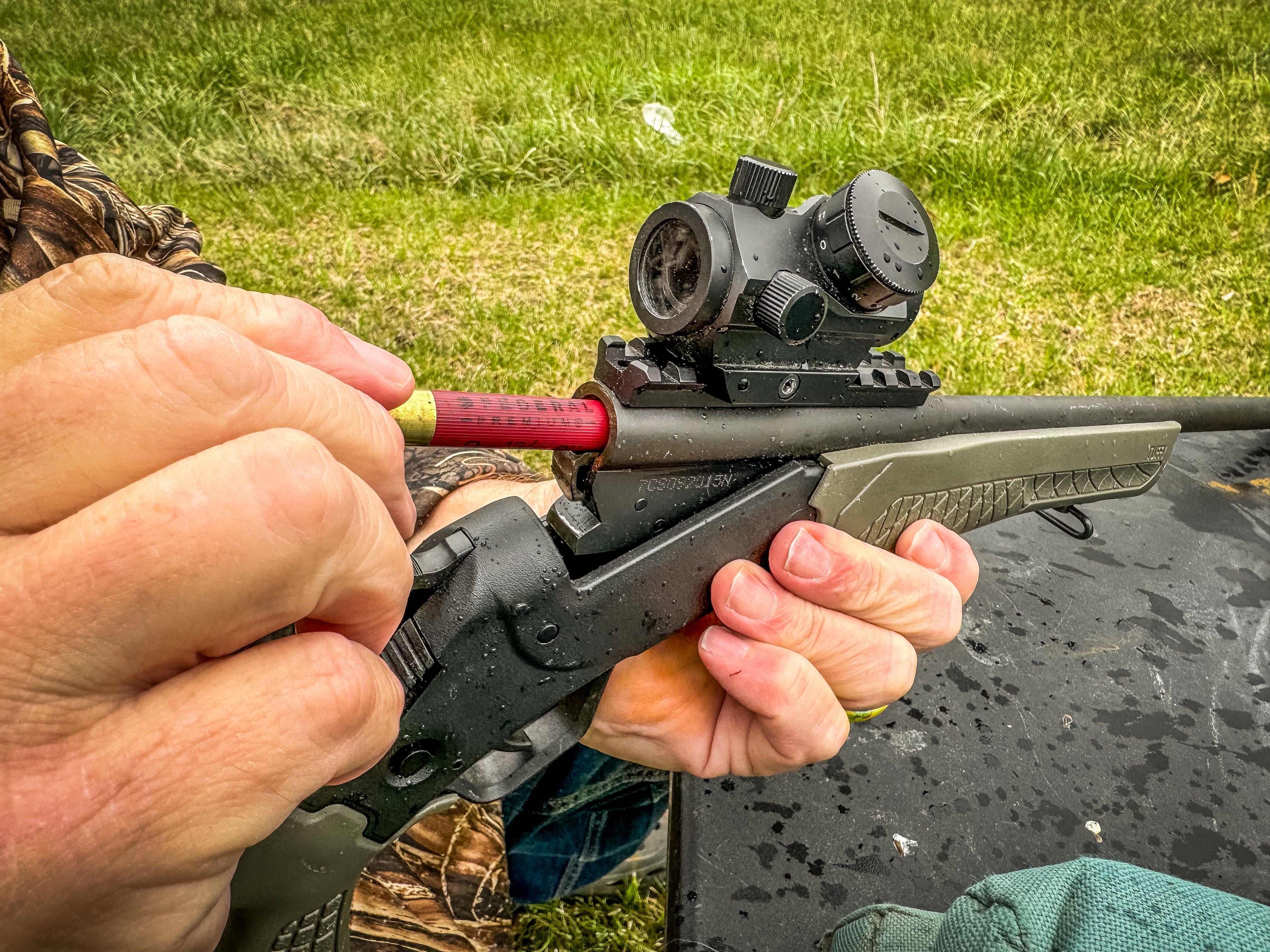
With tight patterns and lighter payloads, a red-dot scope will help keep you on target. Image by Michael Pendley
I didn’t bother counting number of hits in the turkey vital target, but instead flipped the targets over and traced the circle around the densest part of each pattern. I would be 100% confident with any of the tested loads out to 30 yards and even beyond with a few of them. Will your gun pattern each load the same as mine? Probably not. The only way to know what works best is to pattern multiple loads through your gun and choke combination.
***Don’t Miss: *THE BEST 20-GAUGE TURKEY LOADS OF 2024
THE LOADS
Federal Premium TSS
No. 9 shot
1,100 FPS
13/16-ounce payload
Hits in circle: 169
One of the most popular and readily available brands of turkey loads the past several years, Federal Premium offers a .410 load of No. 9 shot with a roll crimp and full-length wad for dense, consistent patterns.
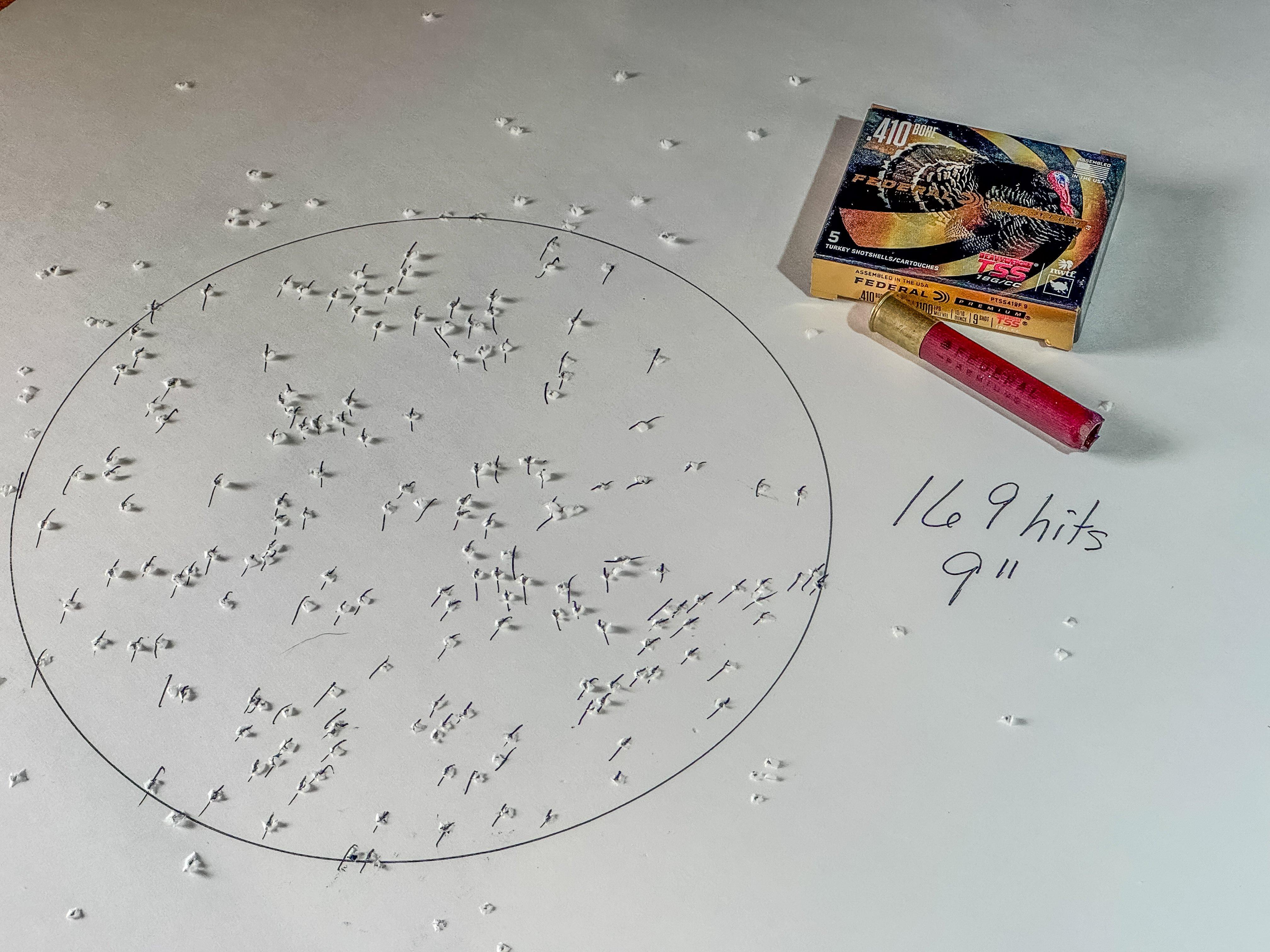
The Federal Premium TSS No. 9 averaged 169 hits in a 9-inch circle. Image by Michael Pendley
Remington Premier TSS
No. 9 shot
1,100 FPS
13/16-ounce payload
Hits in circle: 146
Big Green’s entry into the .410 TSS turkey load game is the Premier TSS. This one is packed with 13/16 ounce (about 220 pellets) of No. 9 shot, and Remington says each load is tuned for maximum pattern density.
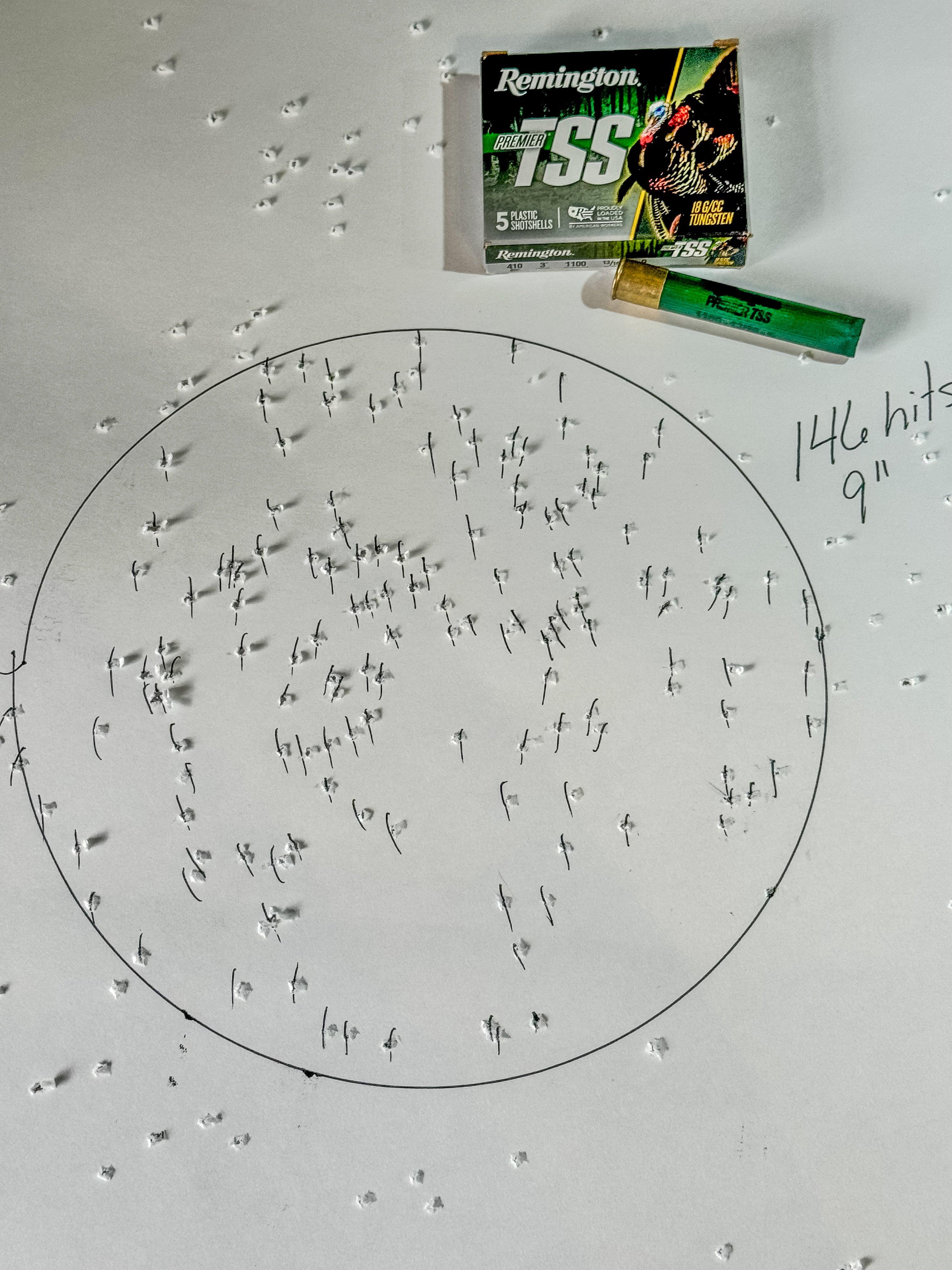
The Remington Premier TSS No. 9 averaged 146 hits in a 9-inch circle. Image by Michael Pendley
Hevi-18 Turkey
No. 9 shot
1,090 FPS
13/16-ounce payload
Hits in circle: 135
Hevi Shot was the pioneer of heavier-than-lead tungsten shot, and the company put that experience to work with its Hevi-18 .410 load. With a crimp-seal resin that resists damage and holds buffer in the shells, these shells are made to pattern tightly.
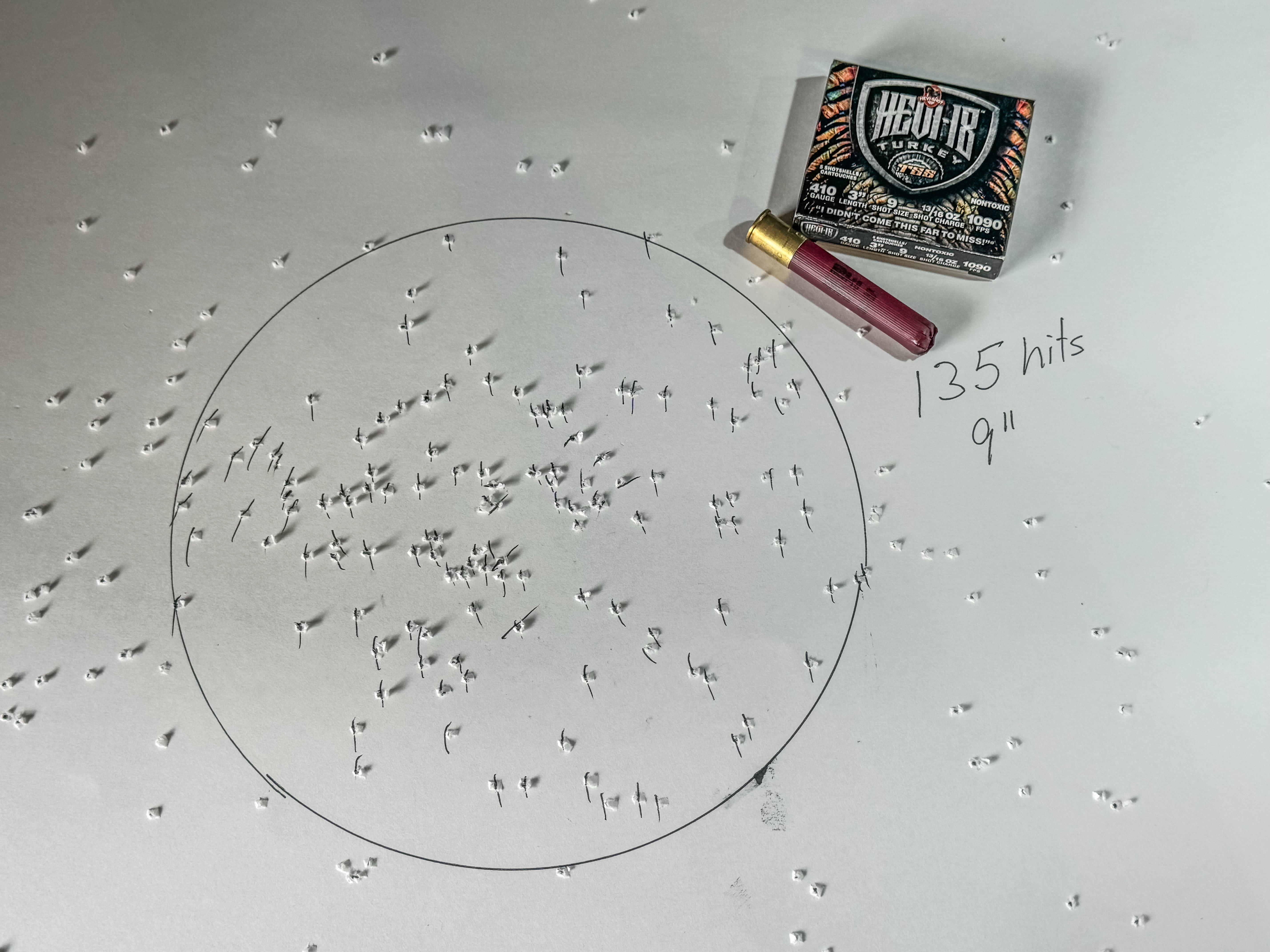
Heavy-18 Turkey No. 9 averaged 135 hits in a 9-inch circle. Image by Michael Pendley
Browning TSS Tungsten Turkey
No. 9 shot
1,100 FPS
13/16-ounce payload
Hits in circle: 183
Browning says its .410 turkey loads feature a buffered payload that improves shot flow through choke tubes for tight, consistent patterns. It came in second overall for the test in total number of hits in a 9-inch circle out of all the loads tested, and first among the No. 9 loads.
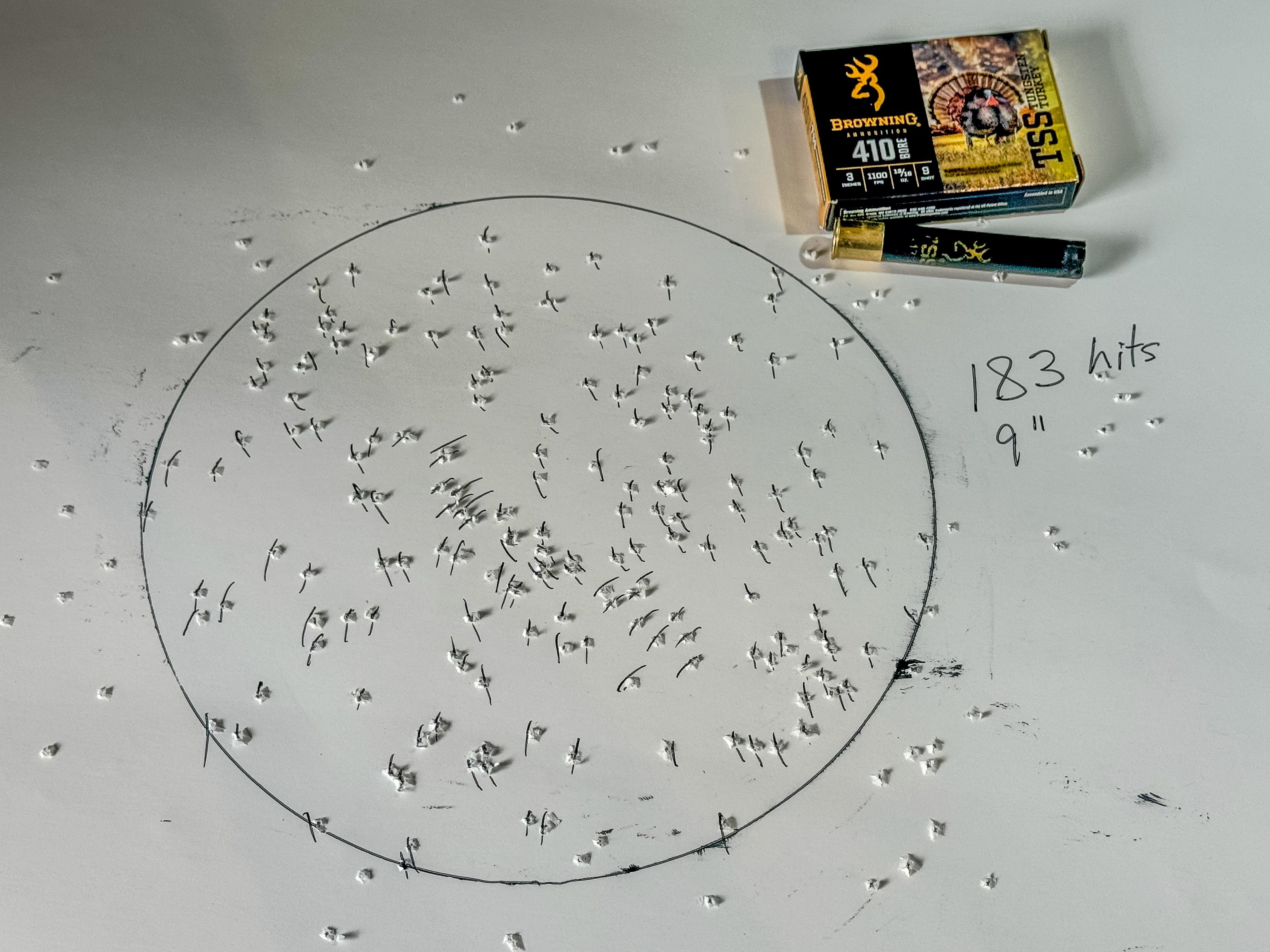
Browning’s TSS Tungsten Turkey put a whopping 183 No. 9 shot in a 9-inch circle. Image by Michael Pendley
BOSS TOM
No. 10 and No. 9 shot sizes
1,050 FPS
⅞-ounce payload
Hits in circle: 207 (No. 10) and 137 (No. 9)
BOSS Tom out of Michigan sells directly to consumers and hand-assembles each load. It was the only shell tested to offer a No. 10 load along with the more common No. 9. It had the largest payload of any of the shells we tested by 1/16 ounce. The No. 10 load packs a whopping 460 pellets, and it showed on the target with the densest pattern of the test.
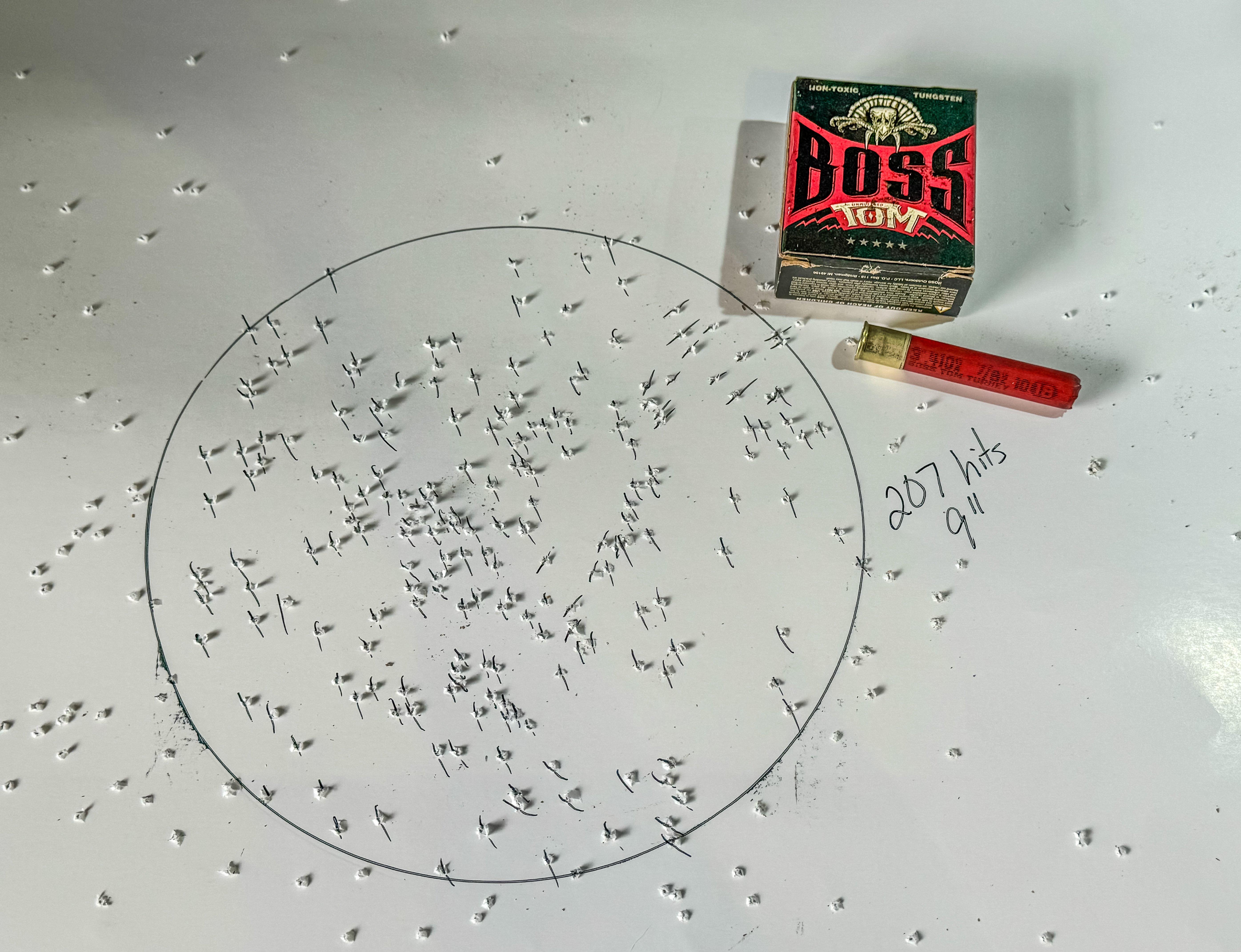
The BOSS No. 10 shot load produced the densest pattern of the test. Image by Michael Pendley
Winchester Double X Diamond Turkey
No. 7.5 lead
1,100 FPS
¾-ounce payload
Hits in circle: 78
Although the other loads tested featured TSS shot, they also will set you back $5 to $8 per trigger pull. Want to hunt with a .410 but not spend that much money? Winchester has you covered. It offers the Double X Diamond Turkey loaded with No. 7.5 lead shot. Copper-plated and blended with 8% antimony to produce denser, harder hitting shot, these loads will work if you do your part. Because the small lead shot loses downrange energy at a much faster rate than the denser TSS loads in the test, my personal belief is that this is a 25-yard-and-closer load. If you are patient enough to get a gobbler that close, these shells should do the job.
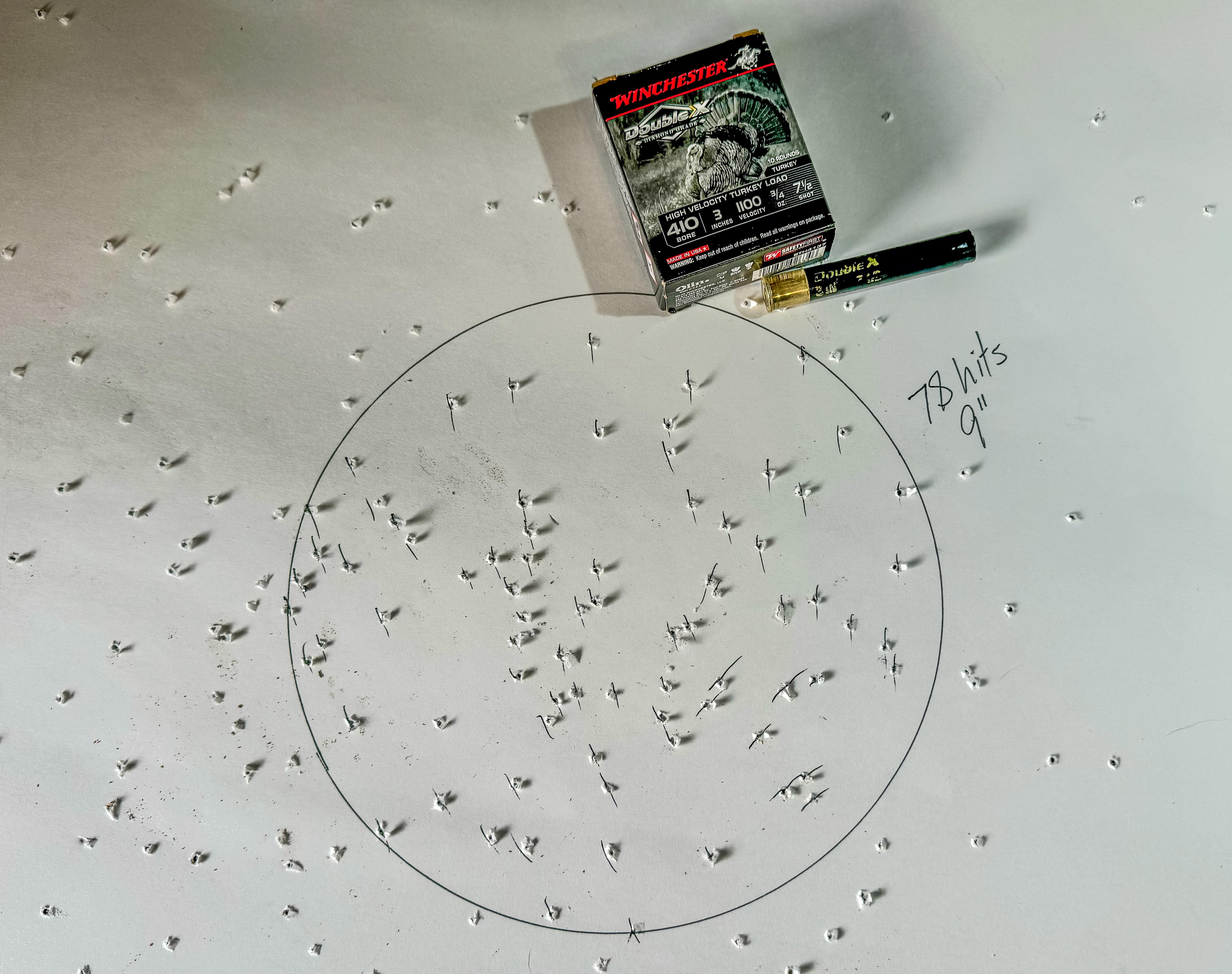
The only non-TSS shell in the test, the Winchester Double X Diamond will do the job if you are patient enough to get a tom in super close. Image by Michael Pendley
Will a .410, even one loaded with TSS shot, kill a turkey from as far away as a 12-gauge or a TSS-loaded 20, with as much margin for error on a slightly misplaced shot? Maybe not. But these loads prove that for hunters who are patient enough to get a bird to about 30 yards or so, they are more than up to the challenge. If you are ready to put down that big, heavy magnum shotgun and pick up a featherweight .410 that won’t make you wonder whether it’s your head or shoulder that hurts more after every shot, one of these loads will be the perfect fit.


